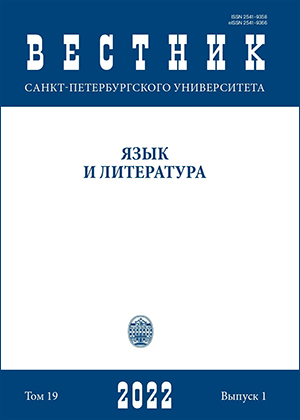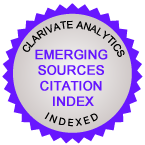Phonological and graphic representations of words in mental lexicon: Homophone processing while reading
DOI:
https://doi.org/10.21638/spbu09.2022.110Abstract
This article presents an experimental study of the role of phonological representation of the word in lexical access during silent reading in Russian. The the phonological component in reading (i. e. whether semantics can be accessed via phonological decoding or directly from the orthographic image of the word) is actively discussed in modern psycholinguistics. Homophones can serve as a testing ground for these hypotheses: if graphemes are decoded into phonemes in silent reading in order to access semantics, then homophones will be processed like homonyms, but if semantics are accessed directly from the visual representation of the word, then homophones can be treated as all other orthographic neighbors. We address Russian homophones in order to investigate this question. In a self-paced reading experiment, we show that if a target word is substituted either by a homophone or a spelling control (an orthographic neighbor), semantic incongruence slows down the processing of the post-target region. We show that both homophones and spelling controls cause this processing load, and homophony does not facilitate the processing of semantically incongruent word. Our data give evidence for direct visual access to entries in mental lexicon as dual-route model predicts for experienced readers.
Keywords:
mental lexicon, homophony, silent reading
Downloads
References
Русакова 2013 — Русакова М. В. Элементы антропоцентрической грамматики русского языка. .М.: Языки славянской культуры, 2013.
Федорова 2014 — Федорова О. В. Экспериментальный анализ дискурса.. М.: Языки славянской культуры, 2014.
Цейтлин 2004 — Цейтлин С. Н. К вопросу о возможности спонтанного усвоения орфографических правил. В кн.: Человек пишущий и читающий: проблемы и наблюдения:. м-лы междунар. конф. (14–16 марта 2002). СПб.: Изд-во С.-Петерб. ун-та, 2004. С. 30–39.
Castles et al. 2018 — Castles A., Rastle K., Nation K. Ending the reading wars: Reading acquisition from novice to expert. Psychological Science in the Public Interest. .2018, (1): 5–51.
Clifton 2015 — Clifton C. The Roles of Phonology in Silent Reading: A Selective Review.In: Frazier L., Gibson E. (eds). Explicit and Implicit Prosody in Sentence Processing: Studies in Honor of Janet Dean Fodor.. Ser.: Studies in theoretical psycholinguistics, 46. Springer International Publ., 2015. P. 161–176.
Coltheart 1980 — Coltheart M. Deep dyslexia: a review of the syndrome. In: Coltheart M.,Patterson K., Marshall J. (eds). Deep Dyslexia. .London: Routledge & Kegan Paul, 1980.
Coltheart, Rastle 1994 — Coltheart M., Rastle K. Serial processing in reading aloud: Evidence for dual-route models of reading. Journal of Experimental Psychology: Human Perception and Performance,. 1994, 20 (6): 1197–1211.
Daneman, Reingold 2000 — Daneman M., Reingold E. Do readers use phonological codes to activate word meanings? Evidence from eye movements. In: Reading as a perceptual process.. Kennedy A., Radach R., Heller D., Pynte J. (eds). Amsterdam: North-Holland; Elsevier, 2000. P. 447–473.
Daneman et al. 1995 — Daneman M., Reingold E. M., Davidson M. Time course of phonological activation during reading: Evidence from eye fixations. Journal of Experimental Psychology: Learning, Memory, and Cognition.. 1995, (21): 884–898.
Dennis, Newstead 1981 — Dennis I., Newstead S. E. Is phonological recoding under strategic control? Memory & Cognition.. 1981, (9): 472–477.
Feng et al. 2001 — Feng G., Miller K., Shu H., Zhang H. Rowed to recovery: The use of phonological and orthographic information in reading Chinese and English. Journal of Experimental Psychology: Learning, Memory, and Cognition.2001, (27): 1079–1100.
Frank et al. 2013 —Frank S. L., Fernandez Monsalve I., Thompson R. L., Vigliocco G. Reading time data for evaluating broad-coverage models of English sentence processing.. Behavior research methods. 2013, 45 (4): 1182–1190.
Frost et al. 1987 — Frost R., Katz L., Bentin S. Strategies for visual word recongition and orthographical depth: A multilingual comparison. Journal of Experimental Psychology: Human Perception and Performance.. 1987, (13): 104–115.
Frost 1998 — Frost R. Toward a strong phonological theory of visual word recognition: True issues and false trails. Psychological Bulletin. .1998, (123): 71–99.
Jared et al. 1999 — Jared D., Levy B., Rayner K. The role of phonology in the activation of word meanings during reading: Evidence from proofreading and eye movements. Journal of Experimental Psychology: General.. 1999, (128): 219–264.
Jared, O’Donnell 2017 — Jared D., O’Donnell K. Skilled adult readers activate the meanings of high-frequency words using phonology: Evidence from eye tracking. Memory & Cognition. .2017, (45): 334–346.
Just et al. 1982 — Just M. A., Carpenter P. A., Woolley J. D. Paradigms and processes in reading comprehension. Journal of Experimental Psychology: General. .1982, (111): 228–238.
Kerek, Niemi 2009 — Kerek E., Niemi P. Russian orthography and learning to read. Reading in a Foreign Language.. 2009, (21): 1–21.
Lesch, Pollatsek 1998 — Lesch M., Pollatsek A. Evidence for the use of assembled phonology in accessing the meaning of printed words. Journal of Experimental Psychology: Learning, Memory and Cognition. .1998, (24): 573–592.
Lukatela, Turvey 1994 — Lukatela G., Turvey M. Visual lexical access is initially phonological: 2. Evidence from phonological priming by homophones and pseudohomophones. Journal of Experimental Psychology: General.. 1994, (123): 331–353.
Marcet, Perea 2017 — Marcet A., Perea M. Is neutral NEUTRAL? Visual similarity effects in the early phases of written-word recognition. Psychonomic Bulletin Review.. 2017, (24): 1180–1185.
Newman et al. 2012 — Newman R., Jared D., Haigh C. Does phonology play a role when skilled readers read high-frequency words? Evidence from ERPs. Language and Cognitive Processes.. 2012, (27): 1361–1384.
Stroop 1935 — Stroop J. R. Studies of interference in serial verbal reactions. Journal of Experimental Psychology.. 1935, (18), 643–662.
Tzelgov et al. 1996 — Tzelgov J., Henik A., Sneg R., Baruch O. Unintentional word reading via the phonological route: The stroop effect with cross-script homophones. Journal of Experimental Psychology: Learning Memory and Cognition.. 1996, (22): 336–349.
Van Orden 1987 — Van Orden G. C. A ROWS is a ROSE: Spelling, sound, and reading. Memory & Cognition.. 1987, (15): 181–198.
Witzel et al. 2012 — Witzel N., Witzel J., Forster K. Comparisons of Online Reading Paradigms: Eye Tracking, Moving-Window and Maze. Journal of Psycholinguist Research.. 2012, (41): 105–128.
Русакова 2013 — Rusakova M. V. Elements of the anthropocentric grammar of Russian language.. Moscow: Iazyki slavianskoi kul'tury Publ., 2013. (In Russian)
Федорова 2014 — Fedorova O. V. Experimental discourse analysis.. Moscow: Iazyki slavianskoi kul'tury Publ., 2014. (In Russian)
Цейтлин 2004 — Tseitlin S. N. On the question of the possibility of spontaneous assimilation of spelling rules. In: Chelovek pishushchii i chitaiushchii: problemy i nabliudeniia. Materialy mezhdunarodnoi konferentsii (14–16 marta 2002).St. Petersburg: St. Petersburg University Press, 2004. P. 30–39. (In Russian)
Castles et al. 2018 — Castles A., Rastle K., Nation K. Ending the reading wars: Reading acquisition from novice to expert. Psychological Science in the Public Interest.. 2018, (1): 5–51.
Clifton 2015 — Clifton C. The Roles of Phonology in Silent Reading: A Selective Review. In: Frazier L., Gibson E. (eds). Explicit and Implicit Prosody in Sentence Processing: Studies in Honor of Janet Dean Fodor. Ser.: Studies in theoretical psycholinguistics., 46. Springer International Publ., 2015. P. 161–176.
Coltheart 1980 — Coltheart M. Deep dyslexia: a review of the syndrome. In: Coltheart M., Patterson K., Marshall J. (eds). Deep Dyslexia. .London: Routledge & Kegan Paul, 1980.
Coltheart, Rastle 1994 — Coltheart M., Rastle K. Serial processing in reading aloud: Evidence for dual-route models of reading. Journal of Experimental Psychology: Human Perception and Performance., 1994, 20(6): 1197–1211.
Daneman, Reingold 2000 — Daneman M., Reingold E. Do readers use phonological codes to activate word meanings? Evidence from eye movements. In: Reading as a perceptual process.. Kennedy A., Radach R., Heller D., Pynte J. (eds). Amsterdam: North-Holland; Elsevier, 2000. P. 447–473.
Daneman et al. 1995 — Daneman M., Reingold E. M., Davidson M. Time course of phonological activation during reading: Evidence from eye fixations. Journal of Experimental Psychology: Learning, Memory, and Cognition. .1995, (21): 884–898.
Dennis, Newstead 1981 — Dennis I., Newstead S. E. Is phonological recoding under strategic control? Memory & Cognition. .1981, (9): 472–477.
Feng et al. 2001 — Feng G., Miller K., Shu H., Zhang H. Rowed to recovery: The use of phonological and orthographic information in reading Chinese and English. Journal of Experimental Psychology: Learning, Memory, and Cognition.. 2001, (27): 1079–1100.
Frank et al. 2013 —Frank S. L., Fernandez Monsalve I., Thompson R. L., Vigliocco G. Reading time data for evaluating broad-coverage models of English sentence processing.. Behavior research methods. 2013, 45 (4): 1182–1190.
Frost et al. 1987 — Frost R., Katz L., Bentin S. Strategies for visual word recongition and orthographical depth: A multilingual comparison. Journal of Experimental Psychology: Human Perception and Performance. .1987, (13): 104–115.
Frost 1998 — Frost R. Toward a strong phonological theory of visual word recognition: True issues and false trails. Psychological Bulletin.. 1998, (123): 71–99.
Jared et al. 1999 — Jared D., Levy B., Rayner K. The role of phonology in the activation of word meanings during reading: Evidence from proofreading and eye movements. Journal of Experimental Psychology: General.. 1999, (128): 219–264.
Jared, O’Donnell 2017 — Jared D., O’Donnell K. Skilled adult readers activate the meanings of high-frequency words using phonology: Evidence from eye tracking. Memory & Cognition.. 2017, (45): 334–346.
Just et al. 1982 — Just M. A., Carpenter P. A., Woolley J. D. Paradigms and processes in reading comprehension. Journal of Experimental Psychology: General.. 1982, (111): 228–238.
Kerek, Niemi 2009 — Kerek E., Niemi P. Russian orthography and learning to read. Reading in a Foreign Language. .2009, (21): 1–21.
Lesch, Pollatsek 1998 — Lesch M., Pollatsek A. Evidence for the use of assembled phonology in accessing the meaning of printed words. Journal of Experimental Psychology: Learning, Memory and Cognition. .1998, (24): 573–592.
Lukatela, Turvey 1994 — Lukatela G., Turvey M. Visual lexical access is initially phonological: 2. Evidence from phonological priming by homophones and pseudohomophones. Journal of Experimental Psychology: General. .1994, (123): 331–353.
Marcet, Perea 2017 — Marcet A., Perea M. Is neutral NEUTRAL? Visual similarity effects in the early phases of written-word recognition. Psychonomic Bulletin Review. .2017, (24): 1180–1185.
Newman et al. 2012 — Newman R., Jared D., Haigh C. Does phonology play a role when skilled readers read high-frequency words? Evidence from ERPs. Language and Cognitive Processes.. 2012, (27): 1361–1384.
Stroop 1935 — Stroop J. R. Studies of interference in serial verbal reactions. Journal of Experimental Psychology.. 1935, (18), 643–662.
Tzelgov et al. 1996 — Tzelgov J., Henik A., Sneg R., Baruch O. Unintentional word reading via the phonological route: The stroop effect with cross-script homophones. Journal of Experimental Psychology: Learning Memory and Cognition.. 1996, (22): 336–349.
Van Orden 1987 — Van Orden G. C. A ROWS is a ROSE: Spelling, sound, and reading. Memory & Cognition. .1987, (15): 181–198.
Witzel et al. 2012 — Witzel N., Witzel J., Forster K. Comparisons of Online Reading Paradigms: Eye Tracking, Moving-Window and Maze. Journal of Psycholinguist Research. .2012, (41): 105–128.
Downloads
Published
How to Cite
Issue
Section
License
Articles of "Vestnik of Saint Petersburg University. Language and Literature" are open access distributed under the terms of the License Agreement with Saint Petersburg State University, which permits to the authors unrestricted distribution and self-archiving free of charge.






